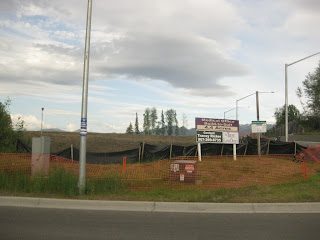Michael Wallerie presented the Gazewood & Weiner plan. He acknowledged some issues in his plan, but said it was more "This is a demonstration that it is possible" to meet the Hickel plan.
It seemed to me the people testifying had a better grasp of the plans and gave more details than a lot of the people who testified in Anchorage. There weren't any people who sounded like they were sent in to make sure the numbers supporting a particular plan were good.
These are the rough notes I took as I was making sure I had everything packed. Like always, BEWARE, these are very rough, just to give you a sense of what was talked about. They have a transcriber and at some point the transcription should be on the Board's website.
Rough Notes:
12:35:
[It took me a while to figure out how to connect. It said there was a number if I wanted to testify, but not just listen. They turned out to be the same numbers. So I got in midstream and assumed it was Michael Wallerie, the attorney who represents the Riley Plaintiffs and who I heard via telephone in the Fairbanks court and saw when he appeared before the Supreme Court.]
Wallerie: Using Borough lines
Boroughs designed to,…
Factor under state constitution
Integrity of Borough lines gets high integrity factor in Constitution
Every borough less than a district is in a single district.
Eery borough that has surplus population - is only split once.
Some discussions about that in the courts and we think the court made it clear, that the courts made it clear that preserving that representation is important.
Biggest problem is treatment with Lake and Pen - if you look at our D38, the Aleutians are kept intact, but are pared with Dillingham area and Bristol Bay which raises issues of contiguity. To maintain integrity of design of plan, it is possible to slip the Lake and Pen district in. . .
One of the problems is logistics of Kodiak B. Surrounded by other boroughs, Lake and Pen, Kenai. Trying to maintain the integrity and representation and rights of Kodiak and L&P. This is a demonstration that it is possible to come up with a Hickel values.
Second part is to demonstrate the treatment of Fairbanks.
A&B - originally decided to ‘shed Democrats” out of Goldstream area. That is no longer an issue any more. Historically, never any ??? in litigation, putting Ester and Goldstream is probably not consistent with Constitution. Justification for the Board was VRA and that is no longer a factor.
Socio-Economic integration is an issue.
Way to deal with Fairbanks problem - ½ district surplus population. We believe that board does not have discretion to assign parts of the borough willy-nilly. A&B Ester and Goldstream placed with ??? region. Problem with SE integration. Our understanding of SE I - Math formula - A+B=C???
No question, rarely examine the issues in depth, because dominated over litigation. Fairbanks is a hub and SE connections with surrounding areas. True and not true. Not about commonalities, but the economic interplay between areas. Not about commonality, but about interplay.
When we look at it - historically - transportation, health care, shopping, common media, educational services - lead to problems with A and B. While Fairbanks is a transportation hub, people in Kaltag go to Fairbanks airport, but not ???
When go to Fairbanks for health go to Fairbanks hospital, not to Ester clinic. Shopping in Fred Meyer and Sam’s Club. People in Ester don’t go to Kaltag to go shopping and vice versa. Family and ethnic connections. Majority of people Ester and Goldstream are non-native and vote on urban lines. They elected Rep Guttenberg.
In rural area, no question that Dick was the preferred candidate - shows these two groups in opposition.
Calista has problems with including Native groups that are not integrated with Ester.
Common media - Fairbanks most tv and radio systems. Some outreach, but not Ester and Goldstream. shared with Ester, but not a direct relationship between Ester and Kaltag.
Ester and Goldstream have ,,,,, [break another phone call]
Borough ?? and your plan B
Prior 2010 in effect plan. Configuration in Anchorage. Where do we need to change the lines to reflect changes in population.
Our understanding that Sullivan and Ruedrich want to scramble the district.
Purpose to adjust the population and not to politically change the districts.
Posible to do whole plan D all basically, when you gt to Anchorage and adjust it for population, not to scramble a district to create new political situations, which has profound partisan implications.
If Board has questions. . .
Torgerson: D39 - Yakutat to Nome?
Wallerie: Areas do follow regional boundary, but what we’ve done there is preserve the line that hsa been in effect since 1990 redistricting. Line that divides the Ahtna region. In your plan D? you don’t do that and may be a better option. Ours is about demonstration. The line was to accomplish VRA goals and not the Hickel process to say.
Torgerson: Questions?
thank you very much for your presentaion
Wallerie: And we look forward to working with you.
Torgerson: We go into public testimony until 4pm, please limit yourselves to 3 minutes. Please spell your name for transcriber.
John David Ragen?: Going to read article in Fairbanks paper yesterday From Ester.
Lance Roberts:
Bolen? Attorney From Fairbanks North Star Borough - goal oriented - interested in contiguity and SE Integration.
Excess needs to be in non-road system should be in SE Integrated
B and Gazewood and Wiener plan work - put NSFB Borough into five districts and surplus into ok district. Assembly will support any other plan that meets the same overall goals
Sorry, that's all I have for you.














